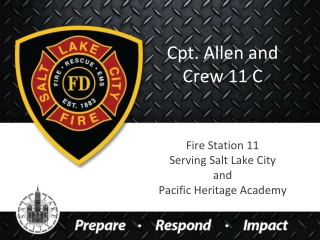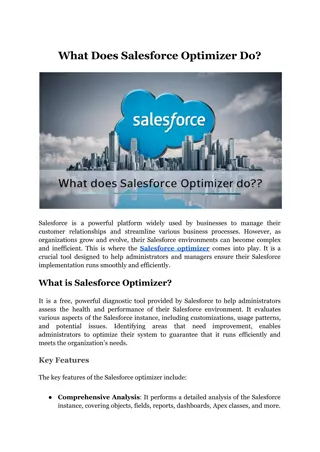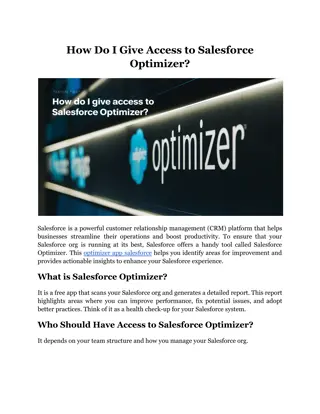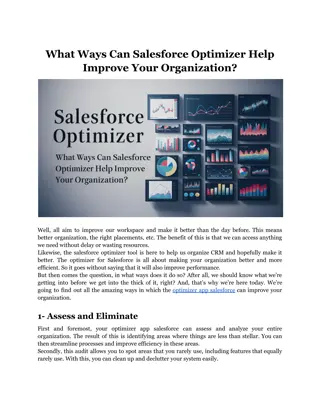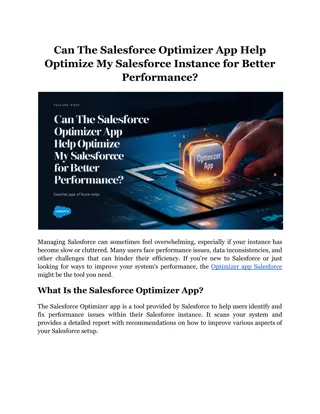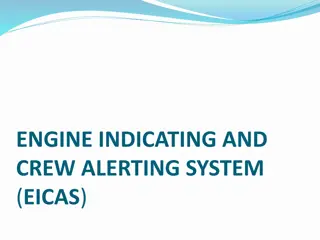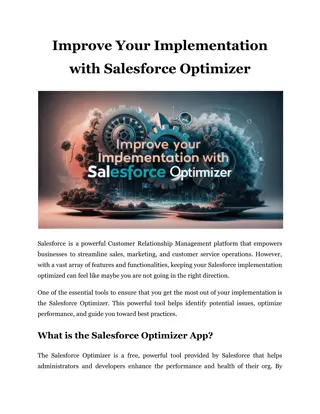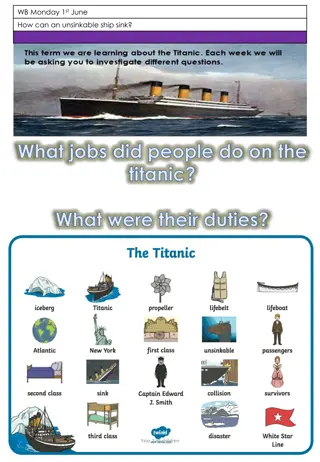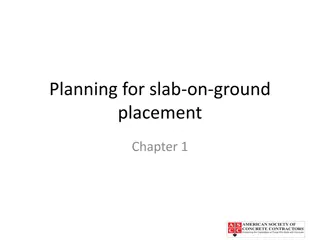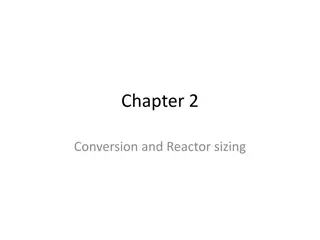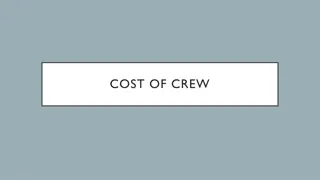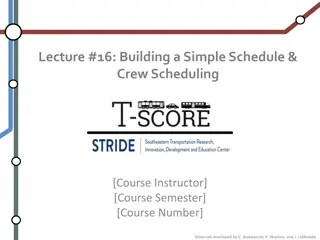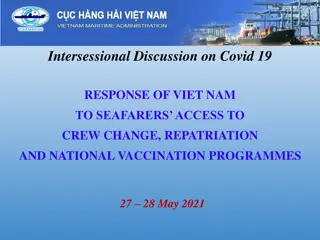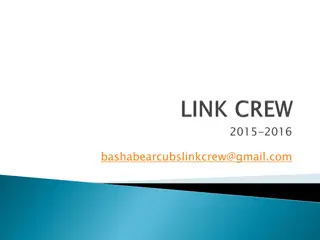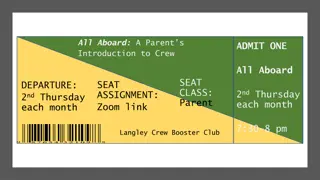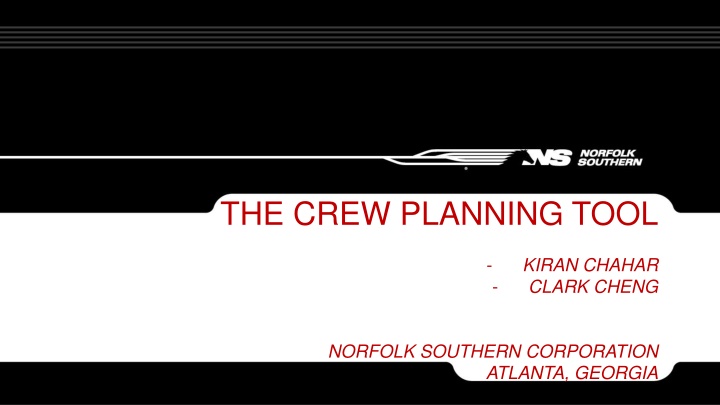
Crew Planning Tool for Optimizing Pool Sizes and Business Processes
Explore a sophisticated crew planning tool by Kiran Chahar Clark Cheng for Norfolk Southern Corporation, Atlanta, GA. Learn how the tool optimizes crew pool sizes and board assignments while ensuring on-time train performance through simulations and adherence to complex business rules.
Uploaded on | 2 Views
Download Presentation

Please find below an Image/Link to download the presentation.
The content on the website is provided AS IS for your information and personal use only. It may not be sold, licensed, or shared on other websites without obtaining consent from the author. If you encounter any issues during the download, it is possible that the publisher has removed the file from their server.
You are allowed to download the files provided on this website for personal or commercial use, subject to the condition that they are used lawfully. All files are the property of their respective owners.
The content on the website is provided AS IS for your information and personal use only. It may not be sold, licensed, or shared on other websites without obtaining consent from the author.
E N D
Presentation Transcript
THE CREW PLANNING TOOL - KIRAN CHAHAR CLARK CHENG - NORFOLK SOUTHERN CORPORATION ATLANTA, GEORGIA
OPTIMIZE THE CREW POOL/BOARD SIZES Problem Definition Find the Optimal sizes for crew boards (regular pools and extraboard) while following the business rules involved in crew-to-train assignment process and maintaining an on-time train performance.
HOW ITS DONE? OPTIMIZING THE POOL SIZES WHILE SIMULATING THE BUSINESS PROCESSES Pool Sizes Train Plan Crew Assigned Service Train Delay Planning Pool-Train Assignments Tool Crew Starts FRA Regulations Crew Deadhead Discrete Event Simulation Business Rules Crew Detention + Pool Sizing Optimization Cost Parameters Crew Utilization OVERVIEW OF THE CREW PLANNING TOOL
HIGH LEVEL PROCESS FLOW Optimization Module Simulation r Replications KPIs Satisfied? Determine Pool Sizes No Yes Fix Pool Size Collect and Report Metrics Output Analyzer Stop
WHY SIMULATION MODEL? BUSINESS RULES ARE TOO COMPLEX TO MODEL ONLY BY OPTIMIZATION Each freight train uses an engineer and a conductor, belonging to a crew pool. Each crew pool has a home terminal and up to five away terminals. Excessive crew wait time at away terminal results in a detention cost. Crew rest rules 10 hours rest at home and away terminal. 48 hours rest after 6 days of service. 3 days rest after 7 days of service. Crew operating rules Maximum on-duty time 12 hours, schedule a re-crew if needed after 12 hours. Crew pool types: Regular, crews wait in a queue to take the next available train. Carded or Scheduled, crews wait in a queue within a certain time period (call window). Extraboard, a pool of crews who support the regular or carded pools.
MORE COMPLEXITIES MODELED USING SIMULATION Complex functionalities modeled: Variation in train departure times and transit times. Variation in crew-availability due to mark-off. Re-crew decisions making process. Schedule a re-crew if crew is on-duty for more than 12 hours and train is not complete. Deadhead decisions making process. Crews can be deadheaded to home or away terminal without operating a train. Detention time decision making process. Pre-defined work-rest calendar for some crew pools. Include limbo time in rest duration if necessary.
TECHNOLOGY USED FOR SIMULATION MODEL Discrete Event Simulation Home grown Java
HIGH LEVEL PROCESS FLOW Optimization Module Simulation r Replications KPIs Satisfied? Determine Pool Sizes No Yes Fix Pool Size Collect and Report Metrics Output Analyzer Stop
OPTIMAL SIZING PROBLEM IS MODELED AS MULTI-CRITERIA SINGLE-DISCRETE-VARIABLE Problem is how many crews are required in regular pools and the extraboard to achieve a target service level. Service level is defined by multiple KPIs considered together. This problem is formulated as a multi-criteria single-discrete-variable optimization model. Used implicit complete enumeration approach. This means we used handful of sizing options by excluding those that are definitely sub-optimal. Used greedy heuristic.
HIGH LEVEL PROCESS FLOW Optimization Module Simulation r Replications KPIs Satisfied? Determine Pool Sizes No Yes Fix Pool Size Collect and Report Metrics Output Analyzer Stop
PROVIDE SINGLE VALUE KPIs - OUTPUT DATA ANALYZER Problem is to incorporate randomness inside simulation model but report out single value results for metrics and pool sizes. The output data analyzing process achieves that using following algorithm: Find sample mean, median and mode for each metrics from the r simulation runs in the last cycle (with optimal pool sizes). Use Bootstrapping to measure variability between sample and population. Calculate new Bootstrapping sample mean_boot, median_boot and mode_boot. Calculate Standard Error (SE) for each estimator (mean, median and mode). Select the estimator minimizing SE.
QUICK RECAP OF THE CREW PLANNING TOOL Cycle 2 Cycle N Cycle 1 RUN 1 (KPIs) Simulation RUN 1 (KPIs) Simulation RUN 1 (KPIs) Simulation RUN 2 (KPIs) Simulation RUN 2 (KPIs) Simulation RUN 2 (KPIs) Simulation Input Optimization Module Optimization Module Output Analyzer RUN ?(KPIs) Simulation RUN ?(KPIs) Simulation RUN ?(KPIs) Simulation PROCESS FLOW
SAMPLE RESULTS Performance per Iteration Total Crews % of Train delays % of Train Cancellations % of Deadhead 80 50% 70 45% % Performance Level 60 40% 35% 50 # of Crews 30% 40 25% 30 20% 15% 20 10% 10 5% 0 0% 1 2 3 4 5 6 1 2 3 4 5 6 # of Cycles # of Cycles Suggest optimal number of crews to achieve target KPI, e.g., 24 crews required in crew pool XY to achieve less than 1% train delays and 0 cancellations.
WHAT-IF CASE STUDY Crew Size vs Mark-Off no Mark-Off 10% Mark-Off 25% Mark-Off 50% Mark-Off 80 70 60 # of Crews 50 40 30 20 10 0 1 2 3 4 5 6 # of Cycles A typical what-if case study to analyze the impact of mark-off rate on crew size to achieve same level of performance.
THE CREW PLANNING TOOL www.nscorp.com

